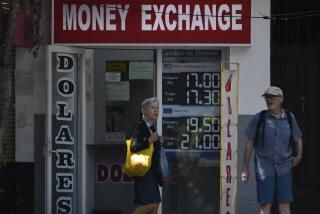Size of Loan Problems Expands : Falling Oil Prices Worry Many Banks
American bankers are watching the free-fall in oil prices with growing anxiety because of their huge loan exposures to Third World oil exporters and domestic energy firms.
However, bankers and bank analysts say, the current decline in oil prices changes the size but not the nature of problems that banks face. U.S. banks have been writing off millions of dollars in loans to Mexico and domestic oil producers for three years and werenât expecting any immediate easing of their difficulties.
The greatest risk is borne by a relative handful of big New York and California banks, which carry the bulk of the $46.9 billion owed to U.S. banks by eight oil-exporting debtor nations. Mexico, which owes $26 billion, poses by far the largest threat if it were to curtail interest payments or default on its loans.
Mexican officials this week told their bankers that the sudden drop in oil prices will force the country to borrow between $8 billion and $9 billion just to keep current on its bills to foreign lenders. The shortfall is twice what was estimated just a month ago and is almost equal to the $10 billion that Mexico will have to pay this year on its loans.
The steady flow of bad news reminds some analysts and international economists of the weeks preceding the explosion of the Third World debt crisis in August, 1982. Mexicoâs default on its loans led foreign banks, governments and international lending agencies to patch together an emergency rescue package that required Mexico to adopt stringent domestic austerity policies as the price for new loans.
Today, Mexico faces a new debt crisis as its foreign exchange earnings shrivel with the falling price of oil. Oil accounts for nearly 70% of Mexicoâs import revenue and every $1-a-barrel drop in oil prices costs Mexico more than $500 million a year in lost income.
H. Robert Heller, Bank of Americaâs chief international economist, said that the situation today is not yet disastrous but that the problems of Mexico and its lenders require immediate attention from the United States and other governments.
âItâs not a financial phenomenon, and itâs not a problem the banks can solve,â he said. âTo throw more money at Mexico will not make Mexicoâs problems go away. It will only make its debt burdens larger and further limit its ability in the future to service its debt.â
Banks generally are reluctant to commit additional funds to Mexico, fearing theyâll just have to write off the new loans somewhere down the road. A concerted international effort is needed to stave off disaster, Heller said.
âThe U.S. government particularly has to start pulling things together,â he said. âThey canât just order the banks to keep pouring money into the country.â
No one yet is calling into question the soundness of the nationâs financial system. While the major banks have lent as much as 88% of their shareholdersâ equity to Mexico and Venezuela, those countriesâ problems are not so catastrophic as to threaten the solvency of any of the banks.
At worst, most analysts say, banks will have to write down some proportion of the loans and accept longer payment terms and lower interest rates.
Investors have already begun to react to the banksâ problems. Since the first of the year, the nationâs five biggest lenders to Mexico have seen their stock values fall between 10% and 20%.
Some analysts are urging their clients to sell their shares in the most vulnerable banks and buy them back later at reduced prices.
Not all observers are so glum about banksâ prospects. Kathleen Cooper, chief economist at Los Angeles-based Security Pacific National Bank, expressed the belief that, on balance, falling oil prices will be good for the banks.
âTheyâll benefit from greater economic growth, lower interest rates and lower inflation,â she said. âMost borrowers will be in a better position. Only a few sectors will be hurt.â
While the problems of Mexico and its big bank lenders receive the most attention, dozens of smaller regional banks stand to suffer millions of dollars in losses on loans to small and medium-size domestic oil firms.
Texas and Oklahoma banks, who as a group have 20% of their loan portfolios in the oil sector, will pay the heaviest toll. The national average is about 3%.
Industry analysts and government officials predict that as many as 130 banks will fail this year, with as many as half of those carried down by loans to shaky energy firms. Many large banks, too, will have to take substantial losses because of loans to U.S. oil firms.
But Cooper of Security Pacific, which has $1.5 billion in outstanding loans to the domestic energy industry, said the costs will be selective. Refiners and integrated oil producers will benefit from lower prices while the independent exploration and production firms will suffer.
The one bright spot in the picture, observers said, was that the gathering crisis may finally force governments and banks to work out a long-term plan for addressing the problems of the debtor nations.
âItâs a game of chicken as to who is going to scream first, the lenders or the borrowers,â said George Salem, banking analyst at the Wall Street investment firm Donaldson, Lufkin & Jenrette. âWe never act until thereâs a dire crisis.â
U.S. Bank Loans to Mexico and Venezuela As of Sept. 30, 1985, in billions of dollars
Percent of Company Amount Equity BankAmerica $4.2 88% Citicorp 4.2 57 Chase Manhattan 3.0 70 Manufacturers Hanover 2.88 83 Chemical 2.15 78 Bankers Trust 1.73 72 J.P. Morgan 1.63 38 First Chicago 1.13 56 Wells Fargo 0.89 62 First Interstate 0.8 32 Security Pacific 0.6 28
Debts of Oil-Exporting Countries to U.S. Banks As of June 30, 1985, in billions of dollars Mexico $25.85 Venezuela 10.57 Indonesia 3.07 Ecuador 2.2 Peru 2.11 Nigeria 1.47 Algeria 0.88 Iraq 0.76 Source: Donaldson, Lufkin & Jenrette
More to Read
Sign up for Essential California
The most important California stories and recommendations in your inbox every morning.
You may occasionally receive promotional content from the Los Angeles Times.










